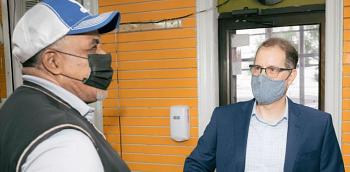The Case for Masking Up Again Indoors in New York City
On Wednesday afternoon, Mark Levine, the New York City Council member and likely the next Manhattan borough president, met me on a busy corner of Broadway, a few blocks from his apartment, in Washington Heights. He had invited me to his neighborhood for a tour and a conversation about mask use in the city. “How is it in there?” he said, jerking his head toward a bodega behind me. He meant mask-wise. We walked in to find out. Inside, a half-dozen people were browsing the cold drinks. A few were masked up, a few had masks across their chins, and some went maskless. Levine, masked, grabbed a bottle of water and made small talk in Arabic with a guy working the register–Levine calls himself a language buff—then walked back out into the afternoon. “I’d say there’s now fifty per cent mask wearing in bodegas, on a good day,” he said. This, for Levine, was bad news.
Levine, who is fifty-two and sports a tidy salt-and-pepper beard, has spent almost eight years on the City Council, where he is the chairman of the health committee. Before running for office, he started his career as a junior-high math and science teacher. This combination of experience and skills became particularly useful in the spring of 2020. Through his government work, he had relationships with doctors and health-care experts. His years in the classroom had made him a patient explainer of complex subjects. He began tweeting prodigiously about COVID-19 and the city’s response to it, and quickly became one of the most active and helpful purveyors of pandemic information in New York. He was thoughtful and thorough, not alarmist or absolutist. “It’s time to update the all-or-nothing messaging on Covid-19 risk,” he wrote in a widely-shared Twitter thread in May, 2020, when the city was still at the height of its pandemic vigilance. “Let’s give people the tools to understand that the riskiness of social activities lies on a spectrum. . . . Given the long road ahead, it’s simply not realistic that we tell people to indefinitely avoid all in-person social contact outside their household.” Within months, Levine’s Twitter account had more than sixty thousand followers, triple the number he used to have. From testing to reopening and vaccine distribution, Levine helped to set the debate and shape the public’s understanding of the pandemic. “It’s very much defined my job for the last year and a half,” Levine told me, of his Twitter activity. “Things are constantly popping in my head that I want to post, or I start feeling that there’s a fight that I need to wage. It can become all-consuming.”



